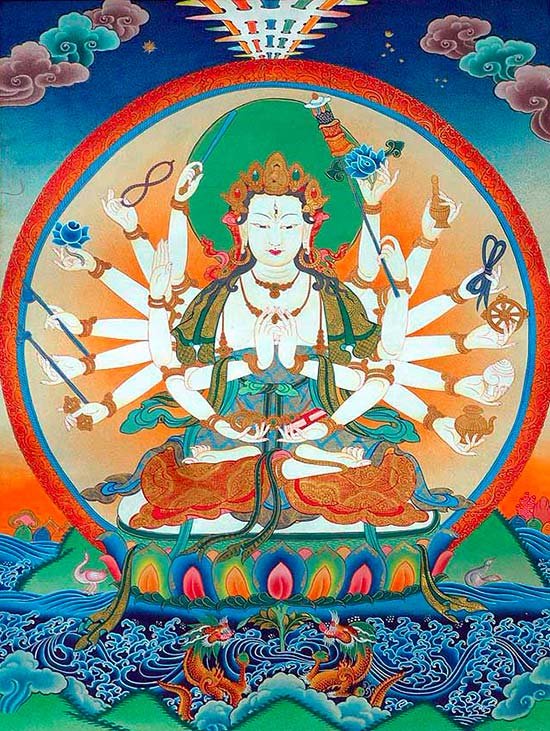Maha Prajnaparamita Sastra
by Gelongma Karma Migme Chödrön | 2001 | 941,039 words
This page describes “prashanta-sutra” as written by Nagarjuna in his Maha-prajnaparamita-sastra (lit. “the treatise on the great virtue of wisdom”) in the 2nd century. This book, written in five volumes, represents an encyclopedia on Buddhism as well as a commentary on the Pancavimsatisahasrika Prajnaparamita.
Appendix 9 - The Praśānta-sūtra
Note: This appendix was extracted from Chapter XXXIX part 2.10 (The power of the destruction of the impurities):
“Furthermore, the śrāvakas know only if their own impurities are destroyed. The Buddhas know that their own impurities are destroyed and also know if those of others are also destroyed. On this subject see the Tsing king (Praśāntasūtra)”.
A sūtra presenting, beside the Buddha, the bodhisattva Mañjuśrī and the devaputra Praśāstavinayeśvara (in Tibetan, Rab tu zhi ba rnam par dul baḥi dbaṅ phyug), a name usually misinterpreted in Chinese as Prāśanta-vinaya-avara: Tsi chouen liu yin according to Dharmarakṣa, (T460, p. 448b3), Tsi tiao fou yin according to Kumārajīva (T 1489, p. 1075c10), Tsi tiao yin according to Fa hai, (T 1490, p. 1081a19). The Chinese have maltreated the name of Avalokiteśvara in the same way, which they most often render as Avalokita-svara. The sūtra in question here deals with conventional and absolute truth (saṃvṛtiparamārthasatya) in its first section. This explains the many titles under which it has been cited. It was translated into Chinese four times (but the second translation has been lost) and into Tibetan once.
1) T 460: Wen chou che li tsing liu king (Mañjuśrīpraśantavinayasūtra), tr. by Dharmarakṣa of the Si Tsin. The colophon of this translation is preserved in the Tch’ou (T 2145, k. 7, p. 51b8–13): The śramaṇa Tchou Fa-hou (Dharmarakṣa), at the capital (Lo-yang), met Tsi-tche of the Western Land who issued this sūtra orally. The sūtra still contained many chapters which this man had forgotten, but what he did issue was soon translated into the language of the Tsin. Having recovered the original, Dharmarakṣa corrected and completed the translation on the 8th day of the 4th month of the t’ai-k’ang year (May 14, 289) at the Po-ma sseu [of Lo-yang]. Nie Tao-tchen wrote it down with the brush.”
This translation was listed in the Tchong king lou (419) of Tchou Tao-tsou (Li, T 2034, k. 6, p. 63a11–12; K’ai, T 2154, k. 2, p. 495a1–2).
2) T 1489: Ts’ing-tsing p’i-ni fang-kouang king (Praśantavinayavaipulyasūtra), tr. by Kumārajīva of the Later Tsin, at an undetermined date between 402 and 409. This was the third translation, also called Tsing liu king (Praśāntavinayasūtra): cf. K’ai. T 2154. k. 4, p. 513a3; k. 12, p. 606b19.
At the end of the sūtra (T 1489, p. 1081a7–9), Ānanda asks the Buddha what he should call it, and the Buddha proposes three titles to him: i) Tsi tiao fou yin t’ien tseu so wen (Praśāntavinayasvaradevaputraparipṛcchā); ii) Ts’ing tsing p’i ni (Praśāntabinaya); iii) Yi ts’ie fo fa (Sarvabuddhadharma).
3) T 1490: Tsi tiao yin so wen king (Praśāntavinayasvaraparipṛcchāsūtra), tr. by Che Fa hai of the Lieou Song (420–479) from an original identical with that of Dharmarakṣa. This was the fourth translation and it was also called Jou-lai so chouo ts’ing tsing tiao fou king (Tathāgatoktaṃ Praśāntavinayasūtram): cf. Nei, T 2149, k. 4, p. 261b26; K’ai, T 2154, k. 1, p. 484c3–4; k. 5, p. 532b23–24.
4) Tib. Trip. no. 846, vol. 34, p. 104–2–7 to 113–5–6: Kun rdzob daṅ don dam paḥi bden pa bstan pa (Saṃvṛtiparamārthasatyanirdeśa. – In Mahāvyut., no. 1368: Paramārthasaṃvṛtisatyanirdeśa), tr. by Śākyaprabha, Jinamitra and Dharmatāśḥila, in the first quarter of the 9th century.
On p. 113, fol. 279a3, the Buddha proposes as the only title of the sūtra: Kun rdzob daṅ don dam paḥI bden pa bstan pa.
This sūtra contrasts the śrāvaka Vinaya with that of the bodhisattva and it particularly notes:
“Personally cutting one’s own bonds of the passions (kleśabandhana) is the Śrāvakavinaya; wanting to cut the passions of all beings is the Bodhisattvavinaya” (cf. T 1489c7–8; T 460, p. 450b16–18; T 1490, p. 1083b1–2; OKC, 846, p. 107, fol. 263a7–8).
This is the passage referred to here by the Traité.
